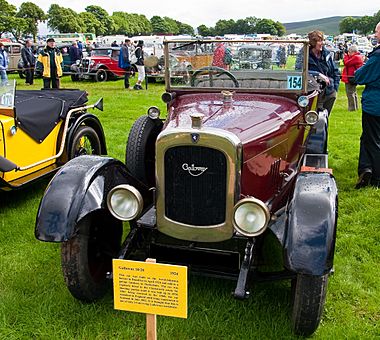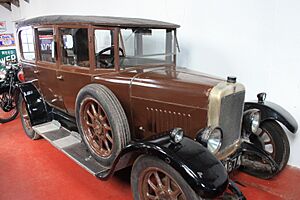Galloway (car) facts for kids
Galloway was a Scottish car company that started in 1920. It was a special part of a bigger company called Arrol-Johnston. The first factory was in Tongland, Kirkcudbrightshire. Later, in 1923, they moved to Heathall, Dumfries. The company stopped making cars in 1928.
Contents
History of Galloway Cars
This car company was very unique because it was mostly run by women! For a while, their ads even said "a car made by ladies for others of their sex." The factory was first built during World War I to make airplane engines.
Thomas Pullinger, who managed Arrol-Johnston, was convinced by his daughter, Dorothée Pullinger, to keep the factory open. She wanted to create jobs for local people. Dorothée became a director of the new company. She started special training and apprenticeship programs just for local women. These programs lasted three years, which was shorter than the usual five years. People thought the girls learned faster and attended more regularly than boys.
The factory was close to the River Dee. A dam with water turbines was built to create power for the factory. A steam engine also helped provide extra power. Fun fact: the factory even had two tennis courts on its roof!
The cars Galloway made were strong and simple. At first, they only made one model, the 10/20. This car was a lot like the Fiat 501.
However, it was a tough time to start a new car company. Only a few hundred cars were made before the Tongland factory had to close in 1923. Production then moved to the main Arrol-Johnston factory in Heathall, which had plenty of space. The old Tongland factory was later used to make silk.
In 1925, a new, bigger Galloway car called the 12 was introduced. This car was basically an Arrol-Johnston model. It was made until Arrol-Johnston itself closed in 1928. That's when Galloway Motors officially shut down. In total, about 4,000 Galloway cars were produced. After Galloway closed, Dorothée and her husband started a laundry business in Croydon called White Services Laundries Limited. They used new American machines and soon had 17 shops!
Galloway Car Models
Here are the main car models Galloway produced:
- 1920-1925 Galloway 10/20 (1460 cc straight-4 engine)
- 1925-1929 Galloway 12 (1669 cc Straight-4 engine)
Galloway 10/20 Car Details
Quick facts for kids Galloway 10/20 |
|
|---|---|

1924 Galloway 10/20 at the annual Biggar Vintage Rally, August 2008
|
|
| Overview | |
| Production | 1920–1925 1800 approx produced |
| Powertrain | |
| Engine | 1,460 cc (89 cu in) Straight-4 Side valve |
| Transmission | 3 speed, later 4 speed manual |
| Dimensions | |
| Wheelbase | 102 or 112 in (2,591 or 2,845 mm) |
| Length | 156 in (3,962 mm) |
| Width | 68 in (1,727 mm) |
The 10/20 model was designed by Thomas Pullinger and others. It was greatly influenced by the Fiat 501 car. It used a 1460 cc, straight-four engine. This engine powered the back wheels through a three-speed, and later a four-speed, manual gearbox. The car's suspension used special springs at the front and rear to make the ride smooth.
The Galloway car had several features designed to appeal to women drivers. Some of these, like a rear-view mirror and a more reliable engine, were helpful for all drivers. The car was smaller and lighter, making it easier to handle. It also had more storage space inside. The driver's seat was raised, giving a better view of the road. The hand-brake was placed conveniently near the driver's seat, not hidden under the dashboard.
Galloway 12, 12/30 and 12/50 Car Details
| Galloway 12 | |
|---|---|
| Overview | |
| Production | 1925–1929 (production numbers not known) |
| Powertrain | |
| Engine | 1,669 cc (102 cu in) Straight-4 overhead valve |
| Transmission | 4 speed manual |
| Dimensions | |
| Wheelbase | 114 in (2,896 mm) |
| Length | 156 in (3,962 mm) |
| Width | 68 in (1,727 mm) |
The engine for the Galloway 12 model was the same as the one used in Arrol-Johnston's 12 hp car. When tested by The Motor magazine, this car could reach a top speed of 51 miles per hour. From 1926, the car was fitted with brakes on all four wheels. At this time, its name was changed from 12 to 12/30. The car was sold for between £325 and £360, depending on its body style. This was quite expensive compared to other cars like Morris and Austin.
See also
- List of car manufacturers of the United Kingdom


